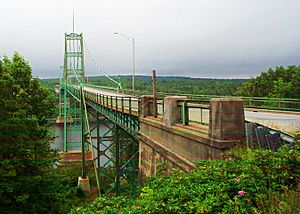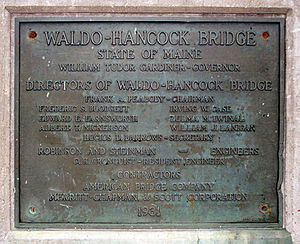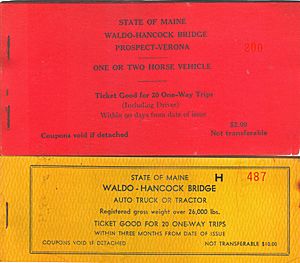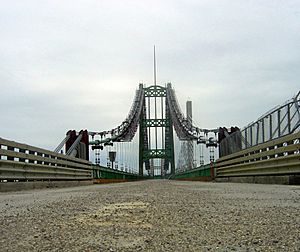Waldo–Hancock Bridge facts for kids
Quick facts for kids Waldo–Hancock Bridge |
|
|---|---|

Waldo–Hancock Bridge in 2001
|
|
| Coordinates | 44°33′38″N 68°48′07″W / 44.560692°N 68.801966°W |
| Carries | |
| Crosses | Penobscot River |
| Locale | Bucksport, Maine, (Hancock County, Maine) |
| Official name | Waldo–Hancock Bridge |
| Maintained by | Maine Department of Transportation |
| ID number | (Bridge No. 2973) |
| Characteristics | |
| Design | Suspension bridge |
| Total length | 2,040 ft (621.8 m) |
| Width | 20 ft (6.1 m) roadway with Two 3+1⁄2 ft (1.1 m) sidewalks |
| Height | 236 ft (71.9 m) |
| Longest span | 800 ft (243.8 m) |
| Clearance below | 135 ft (41.1 m) |
| History | |
| Construction begin | 1929 |
| Construction end | 1931 |
| Opened | November 16, 1931 |
| Closed | December 30, 2006 (Demolished 2013) |
| Statistics | |
| Toll | 1931–1953 |
|
Waldo–Hancock Bridge
|
|
|
Formerly listed on the U.S. National Register of Historic Places
|
|
| Location | Verona, Maine |
| Area | 4 acres (1.6 ha) |
| Built | 1931 |
| Architect | Robinson & Steinman |
| Architectural style | Suspension |
| NRHP reference No. | 85001267 |
| Significant dates | |
| Added to NRHP | June 20, 1985 |
| Removed from NRHP | December 18, 2013 |
The Waldo–Hancock Bridge was a special bridge in Maine. It was the first long suspension bridge built there. It was also the first permanent bridge to cross the Penobscot River below Bangor. The bridge got its name because it connected Waldo and Hancock counties.
This amazing bridge was built in 1931. It served people for many years. In 2006, a new bridge called the Penobscot Narrows Bridge opened very close by. Because of the new bridge, the Waldo–Hancock Bridge was closed. It was then taken down in 2013.
The bridge was about 622 meters (2,040 feet) long. Its main part, between the two towers, was 244 meters (800 feet) long. It had two side sections, each about 107 meters (350 feet) long. The bridge had a road 6 meters (20 feet) wide for cars. It also had two sidewalks, each about 1 meter (3.5 feet) wide. The bridge deck was 41 meters (135 feet) above the water. This height allowed large ships to pass underneath. Building the bridge cost less than $850,000 in 1931. That would be about $12 million today.
Contents
Building the Bridge
Who Designed and Built It?
The Waldo–Hancock Bridge was designed by David B. Steinman. He worked for a company called Robinson and Steinman. The main parts of the bridge were made by the American Bridge Company. The underwater parts were built by Merritt-Chapman & Scott.
New Ideas in Bridge Building
The Waldo–Hancock Bridge was very advanced for its time. It was one of the first bridges in the U.S. to use a new way of making cables. These special cables were made of twisted wires that were already stretched. This method was first used on the Grand Mère Suspension Bridge in Canada in 1929.
Using these special cables saved a lot of time and money. It meant fewer adjustments were needed when building the bridge. Also, the Waldo–Hancock Bridge cables were marked before they were installed. This helped make sure they were set up correctly. These new ideas, created by Steinman, were a big step forward for building suspension bridges.
The Waldo–Hancock Bridge was also the first to use a special design for its towers. This design, called a Vierendeel truss, made the towers look very artistic. It made the horizontal and vertical lines stand out. This cool and effective design was later used on other famous bridges. These include the Triborough Bridge and the Golden Gate Bridge.
Cost and Tolls
The Waldo–Hancock Bridge was known for being built very cheaply. It cost much less than the money the State Highway Commission had set aside for it. Because it was so affordable, they could build a second bridge nearby.
When the bridge opened in 1931, people had to pay a small fee, called a toll, to cross it. This money was used to pay back the loans taken out to build the bridge. After 22 years, on October 31, 1953, all the tolls were removed. The loans had been paid off! The tolls used to range from 10 cents for a horse and buggy to 50 cents for a very heavy truck.
Bridge Repairs and Replacement
Why the Bridge Needed Work
As the bridge got older, engineers from the Maine Department of Transportation regularly checked it. Around its 70th birthday, they found a problem. The two main cables and the many vertical wires holding up the bridge deck were badly rusted. This meant they were not strong enough to hold the road and the cars anymore. It became clear that the bridge needed big repairs and eventually a replacement.
Temporary Fixes and a New Bridge
Work to fix the bridge started in 2000. Companies like Cianbro and Piasecki Steel Construction Corp. worked on strengthening the cables. They fixed one cable at a time. In 2002, they realized the bridge was too damaged for a permanent fix. It would have to be replaced.
So, the work changed to temporary strengthening. In 2003, Cianbro Corp. was hired to add extra support to the south cable. They used special thick wires and new concrete anchors. This temporary fix helped the bridge stay safe until a new one could be built.
A brand new bridge, the Penobscot Narrows Bridge, was built right next to the old one. The new bridge opened on December 30, 2006. On that day, the Waldo–Hancock Bridge was officially closed. Barriers were put up, so no cars or people could cross it anymore.
Taking Down the Bridge
Planning the Demolition
On February 14, 2012, the Maine Department of Transportation announced that the Waldo–Hancock Bridge would be taken down. The plan was to start that summer and finish by fall. The schedule was carefully made to protect two special animals: the Peregrine falcon and the Shortnose sturgeon.
Large barges were placed in the Penobscot River. Sections of the bridge were carefully lowered onto these barges. Today, only the concrete supports in the river remain. The MaineDOT worked with the United States Coast Guard to add lights to these supports. This helps ships navigate the river safely. A company called S&R Corp. won the bid to take down the bridge for $5.35 million.
Demolition Process
The demolition started a bit later than planned, on November 20, 2012. The first things removed were the bridge's flag poles. The entire demolition was finished in June 2013.
Images for kids
-
The Waldo–Hancock Bridge as seen from the Waldo County approach looking toward Verona Island (2001)











